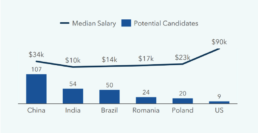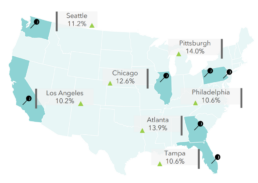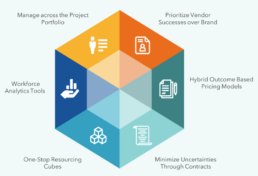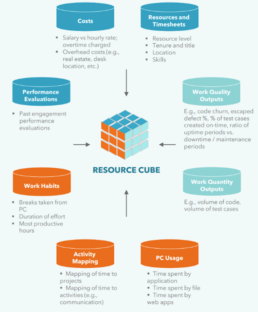DIGITAL DEFLATION IN THE SPOTLIGHT
The rising inflation and impending recession, coupled with the failure of traditional mitigation efforts, make digital deflation a strategic priority
Risk of Stagflation
Inflation has been at its highest level in the last 40 years. The service sector, which has so far dodged the effects of rising prices of goods, is now facing margin pressure due to the price-wage spiral. Accompanying rising inflation is a looming recession on the horizon. The odds of the U.S. economy falling into recession by next year are more than 50% based on various economic indicators.
These macroeconomic developments threaten business profitability as operational costs continue to rise and a slowdown in consumer spending looks imminent. Hence, business leaders seek ways for strategic cost reduction to weather the storm and emerge stronger on the other side.
Failure of Traditional Mitigation Efforts
As businesses look for ways to reduce costs, they stumble upon a common roadblock: conventional ways of cost reduction are becoming ineffective. Price hikes and renegotiating vendor contracts to counter rising input costs do not always work.
Increasing prices may result in diminishing sales volume as customers way be unwilling or incapable of bearing additional costs. Even if customers are ready to shoulder the burden of inflation, businesses can transfer only a portion of the additional cost, resulting in thinner profit margins.
Renegotiating vendor contracts may not work either. Vendors may agree to relax prices in exchange for either long-term demand commitments or greater purchase volumes. Such long-term contracts may leave businesses stuck with uncompetitive rates if inflation is transient. Increasing purchasing volume may also be ineffective as vendors struggle to meet current demand due to the ongoing supply chain shocks and labor shortages.
Hence, driving digital deflation is one of the most effective ways to mitigate cost pressure in this environment
THE IT RESOURCING IMPERITIVE
Technology is a powerful deflationary force. In the past decade, businesses have embraced the cloud, big data analytics and other Industry 4.0 technologies to operate faster, better, and, cheaper, saving them billions of dollars. Programs such as Intelligent Automation can streamline processes, freeing up employees for high impact work. At the same time, Artificial Intelligence can complement decision making through predictive insights, resulting in better resource planning and utilization.
As businesses accelerate their digital deflation efforts, availability of quality tech talent is crucial to success.
Contingent workers couldn’t be more critical to businesses’ talent strategy than now as labor market undergoes an extraordinary shift: hiring local talent has become increasingly difficult and expensive due to a) growing skillset gap, and b) rising tech wages. Such workers bring in the needed expertise, experience, and innovation at scale.
Growing Skillset Gap
Businesses find hiring qualified talent in the local market challenging as employee skills fail to keep pace with emerging technologies. Simply put, there aren’t enough individuals with the appropriate technical training to fill the number of open positions. The US market has high talent scarcity compared to the Indian and Chinese market with better talent availability at moderate rates (see exhibit 1).
Exhibit 1. Potential candidates per opening; median salaries
across AI, Automation and IoT5 (#,$,2021)
Rising Tech Wages
Demand for specialized employees, accelerated by the pandemic, continues to remains strong, making hiring talent expensive. U.S. employers posted 1.1M tech jobs in Q1 2022, a 43% increase from Q1 2021. Businesses are in no mood to slow down as 78% of businesses executives say they will continue or grow digital investments despite inflation. This development will push the already inflated tech salaries (see exhibit 2) to even higher levels.
Hence, businesses rely on contingent workers to meet their needs for additional talent and subject matter expertise
Exhibit 2. Tech. wage inflation across US (%, 2021)
RESOURCING FOR DIGITAL DEFLATION
As technology resourcing comes to the forefront of digital deflation, partnering with the right vendors and managing them cost-effectively is the ‘Holy Grail’ for success.
New ways of vendor management are needed as the nature of resources evolves. Historically, businesses engaged with resourcing vendors for commodity services such as infrastructure management, software development, help desk, etc.
Now, vendors are undertaking higher value work by building customized, modern, client-facing solutions. Third party resources are no longer just for labor cost arbitrage but are a means to access domain knowledge and industry expertise. Exhibit 3 below outlines a few techniques to maximize the value generated from third-party resourcing.
Exhibit 3. Resourcing For Digital Deflation
Chose Vendors Based on Proven Successes, Not Just Brand Awareness
As the resourcing landscape evolves and focus shifts on delivering novel, innovative solutions, the market dynamics are shifting in the favor of tech specialists. Digital deflation initiatives require more in-depth technical knowhow and experience with advance technologies. Hence, businesses should re-evaluate their vendor portfolio for domain knowledge, industry experience and past proof of delivery.
Incumbent vendors should also be re-evaluated on their innovation track record. Although they have good business understanding and longstanding relations, they may be too
wedded to the usual ways of doing business to think out of box. Incumbents may also lack incentives to drive process efficiencies due to the extra investment required and the likely reduction in their fees.
Today, businesses should consider expanding vendor portfolio to include niche vendors. Niche vendors typically have stronger technical capabilities as they do not carry the burden of legacy business allowing them to make faster strides in digital space. Additionally, they have a stronger domain expertise if they specialize in a particular industry.
Niche vendors are also often more agile, with faster time-to-market and the ability to develop innovative solutions.
Favor ‘True’ Hybrid Outcome Based Pricing
Traditional pricing models are unfit for digital initiatives with dynamic scope and may lead to high cost and poor-quality outputs. T&M models provide vendors little incentive to deliver projects on schedule as it makes economic sense for them to maintain a steady stream of revenues for the longest time. On the other hand, fixed fee models assume that the customer’s demands are fully understood long before implementation, leaving the customer bound to outcomes that may no longer be desired.
Pure play outcome-based models do not work either as vendors are unwilling to risk payments entirely on project outcomes with dynamic scope and volumes.
Businesses should utilize hybrid outcome-based pricing models with fixed services-based fee when the project scope is not well defined and incremental fee when the outcomes are predictable. The Fixed fee should be based on the vendor inputs (e.g., resource cost) and the incremental fee on the business outcomes (e.g., cost reduction, revenue gain etc.).
This model results in tangible benefits for both parties involved. Businesses get quality output without incurring any unnecessary cost, which translates to vendor gains.
Minimize Uncertainties through Contract
In addition to using hybrid pricing model, businesses should review their contractual terms to match the needs of new age digital focused projects.
Provisions for scope discovery should be included to better deal with digital initiatives’ uncertainties. Defining an initial discovery phase, based on agreed upon pricing, can help fulfil senior stakeholder commitments while reducing the ambiguity around scope and requirements.
Contractual flexibility to deal with scope changes (SLA revisions etc.) should also be built in. One way to build flexibility is by defining change procedures for realignment with evolving technology or business needs. These procedures should be established so everyone involved understands that modifications are inevitable and help prevent defensive behavior.
Further, businesses should reassess contract terms form a lens of inflation protection. Vendors might trigger cost of living expenses (COLA) clauses and raise prices to counteract inflation.
These hikes should be carefully reviewed as most offshoring locations have a broad trend of currency depreciation that offsets higher inflation costs. For example, rise in inflation is matched by currency depreciation in India (see exhibit 4).
Exhibit 4. Inflation and USD Exchange Rate in India9
($,% 2018-2022)
Additionally, vendors might also replace more experienced, expensive resources with less experienced, cheaper resources or transfer the entire burden of inflation onto the shoulder of buyers without taking a hit on their margin. Business should make their COLA clauses more robust to avoid being stuck in any of these scenarios.
Manage across the Portfolio of Investments
Digital initiatives often have a high degree of interdependence and cross functionality and hence, are complicated to manage. They may produce suboptimal outputs with rather indiscreet management of resources and project costs if not managed properly.
Centrally managing the project portfolio or Project Portfolio Management (PPM) can ensure a) alignment with business objective, improving resource allocation b) project outcomes are measurable, facilitating prioritization and c) visibility into project progress and cost, leading to time and budget adherence. Hence, a PPM office should be set up for project governance, providing complete visibility into the projects and improving ROI.
The Need for Workforce Analytics
Digital initiatives are extremely time and budget sensitive; hence, they need quality resources and high productivity levels. Workforce analytics tools can help businesses monitor resource performance by providing visibility into resource productivity and efficiency.
By tracking employee journey in the digital workspace, these tools can provide a multifaceted view of enterprise efforts and correlate efforts to outcome. Beyond resource performance, these tools can help optimize vendor network by enabling supplier performance measurement and hence, are crucial for managing resources and vendors.
One-Stop Resourcing Cubes
Every business should maintain a comprehensive resourcing cube (see exhibit 5) that provides end-to-end visibility across the entire resourcing lifecycle. These cubes can help track and eliminate inefficiencies across the entire project portfolio by analyzing:
1. Resourcing Demand: Eliminate ad hoc demand and ensure teams with right skills and size are deployed
2. Resource Utilization: Optimize full- time equivalents (FTEs) vs contingent workers (CWs) and onshore vs nearshore vs offshore resource mix
3. Vendor Pricing: Ensure pricing compliance by tracking vendor rates (by location and skills), volume discounts,
tenure discounts and year-on-year efficiencies
4. Resource Activity: Ensure quick resource onboarding, offboarding and vendor readiness to meet future demand
5. Vendor Performance: Optimize vendor/ resource performance by tracking productivity levels, SLA adherence and buyer feedbacks
Exhibit 5. Resource Activity Cube
In Closing..
Digital deflation is the most effective way for businesses to manage through today’s environment of high inflation, currency fluctuations, potential recession, and labor shortages. Effective sourcing and third-party technology resource usage is key to realizing digital deflation.
Today, resource management is undergoing a paradigm shift. It is no longer just a means of access to cheap labor, but a source of enhanced capabilities and innovation for designing advanced technology solutions. Hence, businesses should modernize their way of managing third-party resourcing vendors.
To ensure quality, timely and cost-effective implementation, businesses should: a) Partner with vendors with proven successes, rather than brand awareness b) Utilize hybrid outcome-based pricing for equal risk sharing c) Manage uncertainties through contracts to avoid conflicts d) Manage the portfolio of digital investments holistically e) Employ workforce analytics tools to manage resource productivity and f) maintain comprehensive one-stop resourcing cubes to facilitate agile resourcing decisions.
- “Consumer Price Index- July 2022”, Bureau of Labor Statistics
- “Echoes of the Wage-Price Spiral of the 1970s”, The Wall Street Journal
- “Bloomberg monthly survey of Economists” , July 2022
- “Today’s Economic Data compared with previous recessions” The Washington Post
- Global Future in-demand skills 2021”, Randstad
- “Press Release”, CompTIA 2022
- “Press Release”, Gartner 2022
- “Tech Salary trends”, Dice 2021
- “Inflation, exchange rate”, World Bank Open Data




